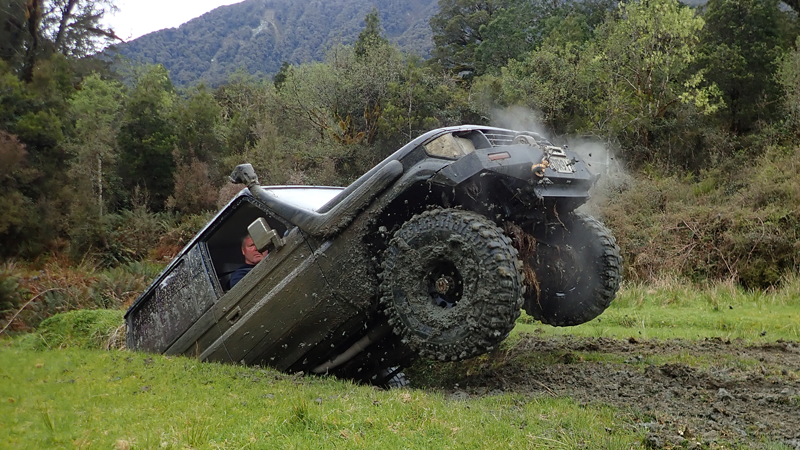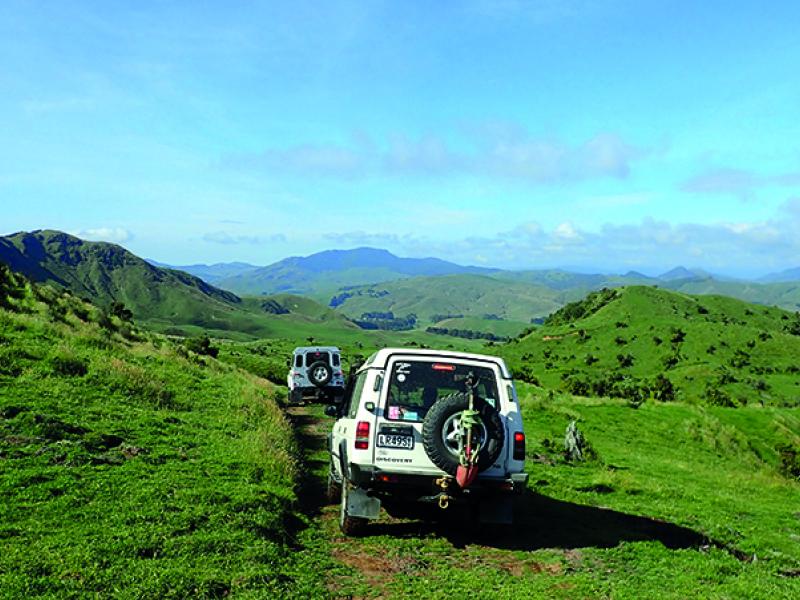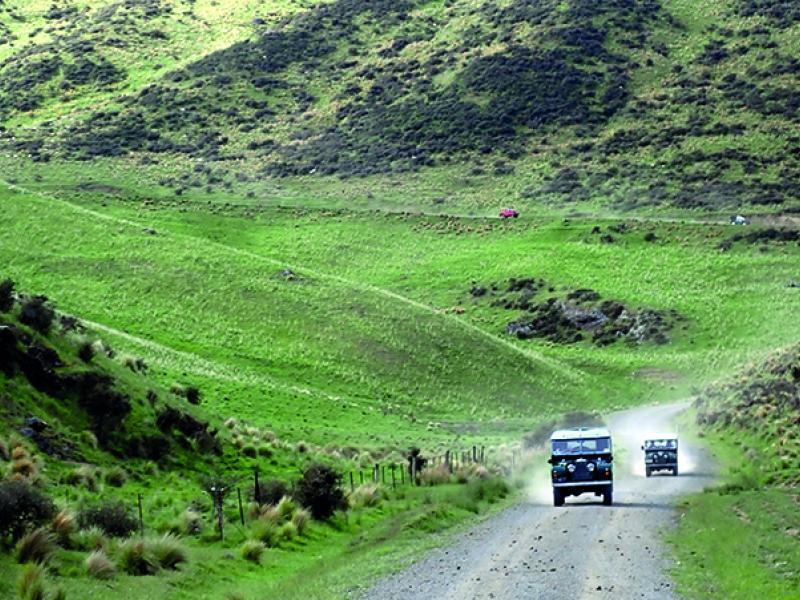The Otago Land Rover Club has been trekking in and out of the supposedly inaccessible Barn Bay in remote South Westland for years. Kevin Isemonger joined members to chronicle their latest trip in and back out again.
Like a lot of great 4WD adventures I have been on and/or party to, this one – in and back out of Barn Bay by 4WD – started with a casual conversation one day.
In this case I was talking (over the phone!) to Rod Corbett from Wanaka during last year’s first big Covid-19 lockdown and he mentioned that the Otago Land Rover Owners Club had booked their annual trip into Barn Bay – “Do you know where that is?”
As it turned out, I did!
Many years ago, I was loaned a book called The Chopper Boys by Rex Forrester. It was a book about the start-up of the deer recovery business, initially dead deer – but later live recovery. It was adventure on a page. There were two major locations in the ‘Wild-West’ – naturally, both very inaccessible, one being the Landsborough Valley, the other...
Barn Bay!
Both locations are in the remote south-west corner of the South Island of New Zealand – and both were hunt and drop zones for deer, where the deer carcases would be “choppered” off the remote mountain tops to drop-zones in the Landsborough and Barn Bay, from where they would then be flown out by fixed wing aircraft to a processing plant in Wanaka.
World-famous in NZ!
Readers ‘of a certain age,’ might also remember a famous edition of popular TV show Country Calendar called ‘The Arawhata Run’ which featured the Nolan Family, who have farmed the south-western Arawhata, Cascade and Barn Bay region for generations.
So, yes, I DID KNOW where Barn Bay was – and I also knew it was on the Nolan’s property still, and it was near impossible to get to.
What I DIDN’T KNOW up until my conversation with Roy, was that the Otago Land Rover Club had been travelling to Barn Bay for decades, the club helping to maintain the fragile track to and from the ‘Bay, by (attempting) to travel there every year.
“Would you be interested in coming along on the next one?” was Rod’s question.
“Would I what?” was my immediate answer and my flights and accommodation were booked the next day – hopeful that the Covid lockdown would end. A month later, however, the airports were closed, and Auckland was locked down a second time.
A close-run thing
It was a close-run thing but eventually the planets aligned for us and we flew into Christchurch the Wednesday before Labour Weekend, stayed overnight at The Hermitage at Aoraki/Mt. Cook (as we had always wanted to) then drove through to Wanaka for groceries, then on to Haast for Thursday night.
We met some of the crew when we arrived at the Aspiring Court Motel, Mark + Karen Koops from Wanaka, and the Trip leader Gareth McLachlan. It soon became obvious, that Rod would be driving the only Land Rover in this year’s Otago Land Rover Owners Club run!
Early Friday morning, it was a quick breakfast, pack a lunch – plus some extra food and clothing in case we need to stay the night – “Sorry, what was that”?
We all convoyed up, with most vehicles being trailer princesses, due to the excessive modifications made to these purpose-built vehicles. We knew we were in for an interesting trip.
Off down the Haast–Jackson Bay road we roared, crossing the many bridges over the streams and rivers that enter the greater Jackson Bay area – through stunning ancient wetland Podocarp forests of Kahikatea, Miro, Totara, Rimu and Matai.
Because it was Whitebait season, the riverbanks were covered with makeshift shelters and tiny rickety jetties, with keen locals and visitors alike hoping to net enough for a decent fritter as the breathless mist hung in delicate wisps up the valleys and above the streams we crossed.
Road’s end
Once we crossed the Arawhata River bridge and turned off over the small ridge that separates the Arawhata from the Jackson’s River, we followed the loose metal road for another 15km before leaving the Jackson’s over the ridge to the Martyr River before roads end at a very substantial ‘railway-track’ gate.
I had been this far twice before, the first time in our Series 3 Land Rover in the mid 1980s, and last time in our then, new Defender in 2007. From here on, is private property. ‘Cascade South Westland Ltd’ had purchased the middle block called the ‘Cascade’ off the Nolan’s some years ago, so permission (and the key) had to be sorted from them, as well as the Nolan’s, well in advance.
Once through the gate, we unloaded the ‘bush-trucks’ – aired down the tyres and headed out to face the mighty Cascade River. This is a typical southern river; stony based, very fast moving, and liable to change from ‘just plain deep’ to ‘freaken deep’ in less than a truck length.
We were all quite happy to watch (in mesmerising silence) as Gareth took the first line across the river – then the next vehicle, then Mark and Karen in front of us, as we watched the three-tonne grey and red Land Cruiser drift sideways in the current just before the far side of the 100m wide river section deemed to be the ‘shallowest bit’.
Our turn
As the water started to come over the bonnet on the four-inch lifted vehicle on 32-inch tyres (!), I noticed that Rod had removed all of the soft carpets and spongey under floor insulation, and since all Land Rovers have outward sloping floors, draining the surplus water that inevitably seeped inside, was relatively easy, when compared to most of the Japanese vehicles that have the aptly named ‘foot-wells’ – that turned into foot-baths.
The vast expanse of the Cascade River flat is made up of near bottomless peat bogs, river silt and rocks, all sitting on top of a solid granite base, so the ‘world leading’ rainfall of the area can change the entire landscape in a single large weather event, including the Cascade’s main course to form equally deep tributaries, which is where we had our first ‘geotechnical’ opportunity.
The gentle slope in, with a near vertical exit comprising of river silt and peat, proved too much for the 32-inch mud tyres, so we were recovered by the 50-inch tractor tyred Land Cruiser buggy of Gareth.
We travelled through a reasonable track through otherwise impenetrable dense rainforest before popping out an a grand pastural scene hacked from the bush and fenced generations before using sturdy Beech tree strainer posts.
We then passed a cottage and followed a dead straight line down the edge of the bush (clearly visible on Google Earth) before we hit the not-so-well maintained bush track to Dee Creek, which we followed for a bit before returning to the bush track to skirt around the lower slopes of the 1,000m high Dee ‘Hill’ (Hill?).
Base layer
As mentioned, the base here is glacial worn granite, with everything holding hands to stay up-right in a storm; meaning ‘windfalls’ can be quite spectacular, as can landslips, where millions of tonnes of rock and foliage can create some significant challenges for the unprepared 4WD explorer.
About midway between Limestone Creek and Robinson Creek we came across an open patch of bush where a stream had taken a short cut and ripped a slot through the bush and shingle to create an entertaining canyon nearly 2m deep and about 2m across with vertical sides. Some spade work and some horsepower managed to clear a reasonable track across this gut, just in time for morning tea with the friendly West Coast Sandflies.
Not long after we crossed Robinson Creek, the call came across the PRS to grab your chainsaws and come to the front of the convoy. Again, fortunately – the team was well prepared, as this was not just a small obstruction, but some significant tonnage of wood had blown over and completely blocked the track for several metres.
Going around is simply not an option due to the density of the bush, hence why it is essential to keep these tracks clear, or the access to the southern block of the farm will be lost without the use of heavy equipment being brought in.
The tree cleared, we pressed on until we came across another common issue of the area, again due to the shallow granite base and high rainfall, a stream had diverted down the track and scoured out the lower side to create the sidling from hell. The top bank was attacked by the team, and fallen logs and debris were piled up on the lower side to at least try to keep the side panels off the unforgiving open rock face on the lower side.
But wait – there’s more
About 1:00pm, the track levelled out and around the corner we found a stunning modern hut – and a group of the advanced party rubbing their necks while staring off into space – which turned out to be the track.
Every year, the Hope River grinds its way further north taking millions of tonnes of rocks and debris with it, away from the only river access to Barn Bay.
I have done some extreme off-roading in my time – and yes, even some abseiling, but I don’t ever remember rappelling three-tonne 4WDs down 20m cliff faces before.
With picks, mattocks and spades we attacked the edge of the cliff softening the edge and gouged it by winching a ‘Ground Anchor’ up the slope before attaching Gareth to two other 4WDs and gently lowering the vehicle down the slope – and it worked, so eight more vehicles later, we bumped our way down the Hope River and parked up on the beach to enjoy a well desired lunch and a cuppa.
Time to head back
With bad weather predicted for tonight, and the gentle mist up the Hope river turning to a grey angry mass, Geoff Omnet, a veteran of 25 Barn Bay excursions, informed me that they once had to abandon their vehicles near the Hope and use a satellite phone to organise an evacuation by jetboat, only to come and pick their vehicles up a week later…When Geoff suggested that “We should probably make a move,” I wholeheartedly agreed.
We had left two 4WDs at the top of the bank, just in case – but winching and towing the nine vehicles back up the drop-off was surprisingly easier than we expected. It is simply amazing how motivating a cold night in the bush can be to get everyone working as a team.
Apart from some minor oil flooding of Sam Paddon’s Ute causing some worryingly large amounts of smoke to belch from the exhaust and a cylinder or two deciding not to fire, we were up the bank and, on our way, out just before 4.00pm and reaching the Cascade River less than two hours later – including a stop for afternoon tea.
Gareth again hit the Cascade first. The basic rule of river crossings, is if the first crossing was good – with the wonders of modern GPS, we should be able to hit the same track back – but as we watched Gareth’s vehicle slowly swap ends as it gently floated down the Cascade, the ‘Team’ decided a crossing a tad further downstream would probably be best and it was – albeit up to the windscreen…
We all made it back to the ‘Hard Antler’ Pub in Haast in time for dinner and NO ONE mentioned what fun it would have been spending a night in the bush!
The next day we drove up an old Stock route on the true right of the Jackson River, which the previous winter had all but totally washed out, flooding the track and turning a simple drive into a winch challenge run.
Sunday, we explored the Copper Mine Creek area just north of Haast, with similar results to the Jackson River. Most vehicles managed to turn around, but the forward party required a huge team effort to recover the vehicles from what is normally a straightforward track.
I cannot thank the Otago Land Rover Owners Club enough for a stunning trip, and what a privilege it was to meet the members and go to Barn Bay. A special thank you to Rod and Anne Corbett for putting up with a couple of Northerners for the weekend as well.
Finally, to see for yourself some of the action from the Barn Bay trip check out the video I made on it on my YouTube channel, ‘Kevz110.







